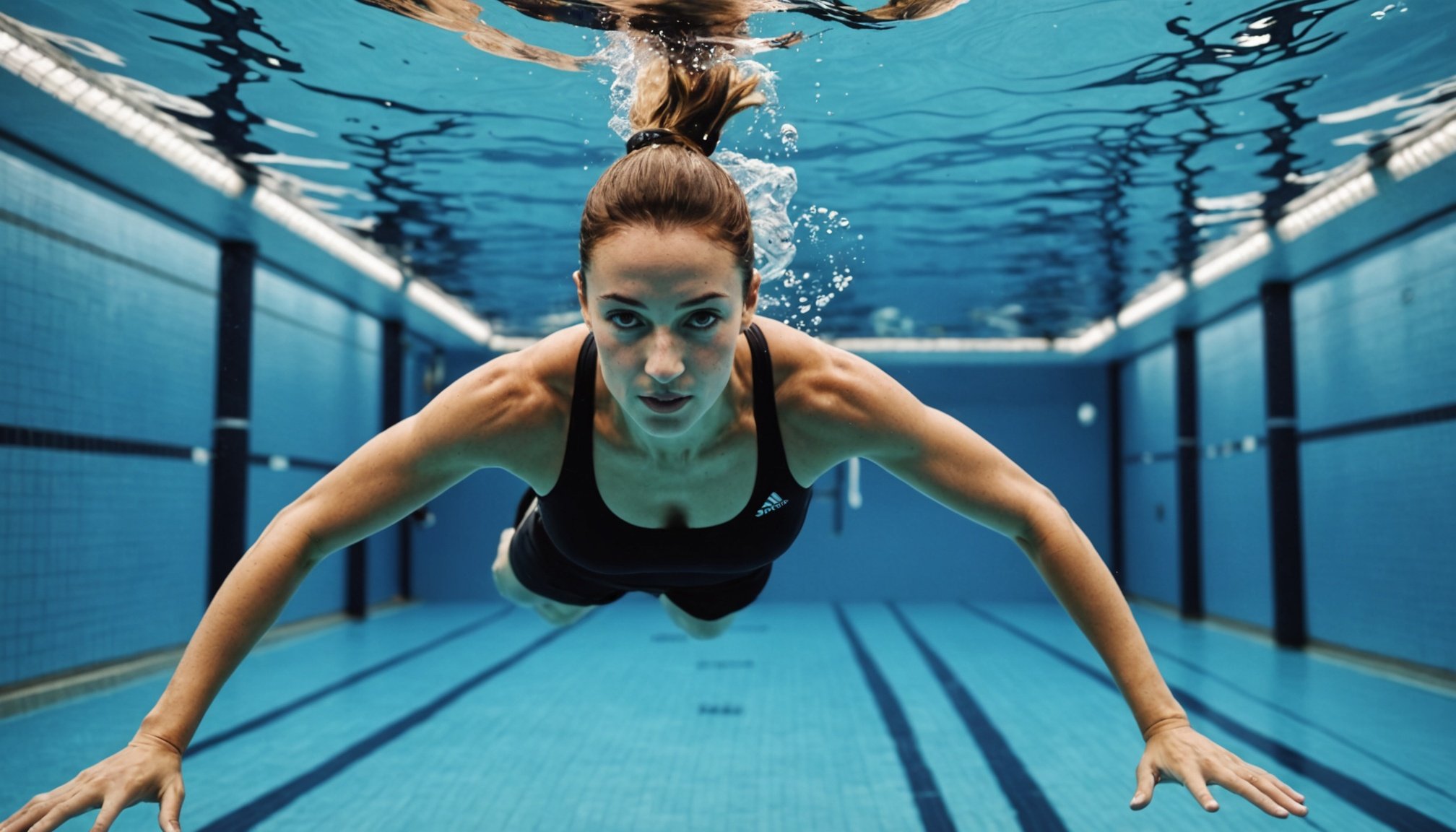Top Underwater Workout Programs for UK Swim Pool Enthusiasts: Dive into Fitness!
Why Underwater Workouts are a Game-Changer
Underwater workouts have become increasingly popular among fitness enthusiasts and swimmers in the UK, and for good reason. These programs offer a unique combination of low-impact exercise, strength training, and cardiovascular benefits, all while minimizing the risk of injury. Here’s why you should consider diving into underwater fitness.
Low-Impact yet High-Intensity
Swimming and underwater exercises are renowned for their low-impact nature, making them ideal for individuals with joint issues or those recovering from injuries. However, this doesn’t mean they lack intensity. Underwater workouts can be tailored to provide a challenging and effective full-body exercise, engaging both your cardiovascular system and muscular strength[3].
Dans le meme genre : Discover the Health and Safety Advantages of Pool Enclosures in the UK
Comprehensive Fitness Benefits
Underwater training encompasses a wide range of activities, from swim-intensive workouts to strength training and even diving techniques. For instance, the Ocean Walker Technique, taught by world record-breaking open water swimmer Adam Walker, focuses on efficient swimming methods that enhance performance and endurance[4].
Best Underwater Exercise Routines
When it comes to selecting the best underwater exercise routines, there are several options that cater to different fitness levels and goals.
A voir aussi : Discover the Benefits of Saltwater Pools Compared to Chlorine Pools in the UK
Swim-Intensive Workouts
- Lap Swimming: A classic and effective way to improve cardiovascular fitness and build endurance. Swimming laps in your pool can be done at various intensities to suit your fitness level.
- Interval Training: Alternate between high-intensity swimming and rest periods to boost your metabolism and improve overall fitness.
- Water Aerobics: Incorporate aerobic exercises like leg kicks, arm movements, and jogging in the water to get a full-body workout.
Strength Training
- Resistance Bands: Use underwater resistance bands to strengthen your muscles without the high-impact stress of traditional weightlifting.
- Pool Weights: Utilize pool weights or water dumbbells to perform exercises like bicep curls, tricep extensions, and shoulder presses.
- Bodyweight Exercises: Perform push-ups, squats, and lunges in the water to engage your core and other muscle groups.
Diving and Snorkeling
- Scuba Diving Training: For those interested in scuba diving, programs like PADI offer comprehensive training that includes both theoretical knowledge and practical diving skills.
- Snorkeling Sets: Use snorkel sets to explore the underwater world while getting a workout. Snorkeling can be a great way to build endurance and enjoy the beauty of aquatic life.
Essential Equipment for Underwater Workouts
Having the right equipment can significantly enhance your underwater workout experience and ensure safety.
Swimming Goggles
- Prescription Goggles: For those with vision problems, prescription goggles can be customized to fit your needs.
- Anti-Fog Goggles: Prevent fogging with anti-fog coatings or treatments to maintain clear visibility.
Wetsuits and Rash Vests
- Wetsuits: Ideal for colder waters, wetsuits provide thermal insulation and protection from the elements.
- Rash Vests: Offer protection from the sun and abrasions, making them perfect for surface swimming and snorkeling.
Diving Equipment
- Mask Snorkel Sets: Essential for snorkeling and scuba diving, these sets include a mask, snorkel, and sometimes fins.
- Gloves and Hoods: Provide additional warmth and protection during dives.
- Buoyancy Aids: Help you maintain the right buoyancy level during dives, ensuring a safe and comfortable experience.
Dry Bags and Swim Bags
- Dry Bags: Keep your gear dry and protected when not in use.
- Swim Bags: Convenient for carrying all your swimming and diving gear to and from the pool or dive site.
Tips for Getting Started
If you’re new to underwater workouts, here are some practical tips to help you get started:
Start Slow
- Begin with short swim sessions and gradually increase the duration and intensity as you build endurance.
- Incorporate rest days to allow your body to recover.
Find a Safe Environment
- Choose a well-maintained swimming pool or a safe diving spot with clear visibility.
- Ensure you have access to necessary safety equipment like life jackets or buoyancy aids.
Seek Professional Guidance
- Consider enrolling in a swimming or diving course to learn proper techniques and safety protocols.
- Join a swimming or diving club to connect with other enthusiasts and gain valuable insights.
Example Routines and Schedules
Here’s an example of a weekly underwater workout routine you can follow:
| Day | Activity | Duration | Intensity |
|---|---|---|---|
| Monday | Lap Swimming | 30 minutes | Moderate |
| Tuesday | Water Aerobics | 45 minutes | High |
| Wednesday | Rest Day | – | – |
| Thursday | Strength Training with Pool Weights | 30 minutes | High |
| Friday | Snorkeling or Scuba Diving | 60 minutes | Moderate |
| Saturday | Interval Training | 45 minutes | High |
| Sunday | Rest Day | – | – |
Real-Life Examples and Success Stories
Many individuals have found significant benefits from incorporating underwater workouts into their fitness routines.
Case Study: The Underwater Club
The Underwater Club, a new online underwater photography school, also highlights the importance of underwater activities for overall fitness and well-being. While focused on photography, the club’s emphasis on spending time underwater can be applied to fitness as well. Members learn to navigate and enjoy the underwater environment, which can be a great motivator for those looking to start an underwater workout program[1].
Testimonial from a Swimmer
“I started swimming laps in my pool three times a week, and within a month, I noticed a significant improvement in my cardiovascular health and muscle strength. It’s been a game-changer for my overall fitness,” says Sarah, a UK-based swim enthusiast.
Preventing Common Ailments
While underwater workouts are generally safe, there are some common ailments to be aware of and prevent.
Swimmer’s Ear
- Use earplugs or ear drops to prevent water from entering your ears.
- Dry your ears thoroughly after each swim session.
Chlorine Rash
- Shower immediately after swimming and apply moisturizer to protect your skin.
- Wear a rash vest or wetsuit to reduce skin exposure to chlorine.
Shoulder Pain
- Warm up before swimming with light stretches and arm circles.
- Use proper swimming techniques to avoid straining your shoulders.
Underwater workouts offer a versatile, low-impact, and highly effective way to achieve fitness goals while enjoying the water. Whether you’re a seasoned swimmer or just starting out, there are numerous programs and routines available to suit your needs. By investing in the right equipment, following practical tips, and being mindful of common ailments, you can dive into a healthier, more active lifestyle.
So, why not take the plunge? Dive into the world of underwater fitness and discover a new way to stay fit, have fun, and enjoy the water.











